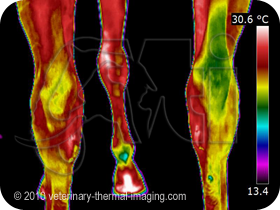Bone Bruises
A bone bruise is bruising of the bone, commonly occuring in the cannon and pastern bone. It is caused when tremendous force is concentrated in one of these areas, causing damage to the bones. Fluid builds up inside the bone and swelling occurs. Because bone bruises are caused by a hard impact, this kind of injury is most common in jumpers and eventers, or horses that are worked on hard ground.
Bone bruises are very painful, despite the fact that they are small and hard to identify without proper equipment. Nuclear bone scans often view a bone bruise as a hot spot, yet pinpointing it exactly with that machine is difficult. The best way to locate it is by using a magnetic resonance imaging(MRI) scan.
The time the horse will need off varies depending on how bad the bruising is, but average he will need to rest for three months before continuing work. Veternarians recommend using anti-inflammatory medications, such as Equioxx, to help with the injury. According to Nan Martin, wintergreen, cypress, and helichrysum are great natural alternatives for bone injuries.
Inflammed Joints
Sometimes, the tissue lining a joint can become inflammed, which if not treated can eventually lead to osteoarthritis. This type of injury can occur in any horse, particularly when the horse's workload suddenly increases. Signs include soreness, stiffness, and less fluid gaits. His joints may swell and feel hot.
 |
| The red represents inflammation. credit |
The best way to treat this injury is give the horse a stall rest and cold-hose his joints daily until they are no longer hot. You also want to reduce inflammation in his joints, which can be done using anti-inflammatory medication. According to Nan Martin, Thyme, Bergamot, and Eucalyptis have been known to work in the same manner. Recovery may take a week or more, depending on the severity of the inflammation. Once your horse has recovered, gradually increase his work load and plan the most intense workouts several days or more apart from each other.
Sore Muscles
It is natural for muscles to be a little sore after a workout, but sometimes they become strained, which commonly occurs in dressage horses, who must work hard to maintain a collected frame. As a result, his back may hurt and become stiff. He may also be resistant to bend, turning, and collecting.
In the scenario that the pain and stiffness does not disappear after rest, or it if reappears, search for other causes, such as a poorly fitting saddle or an unbalanced rider. Massage, chiropractic work, acupressure, or even a thorough currying have been known reduce soreness. Combining massage with essential oils is said to increase it's affectiveness.
***
Remember to always be aware of your horse's condition and well-being. Detecting problems early on can prevent more serious problems from arising, keeping your horse healthy and possibly saving you money in the long run.

No comments:
Post a Comment
Thank you for reading this post! I love to hear from and interact with my readers; it's what makes blogging worth it, so please comment and let me know what you think.